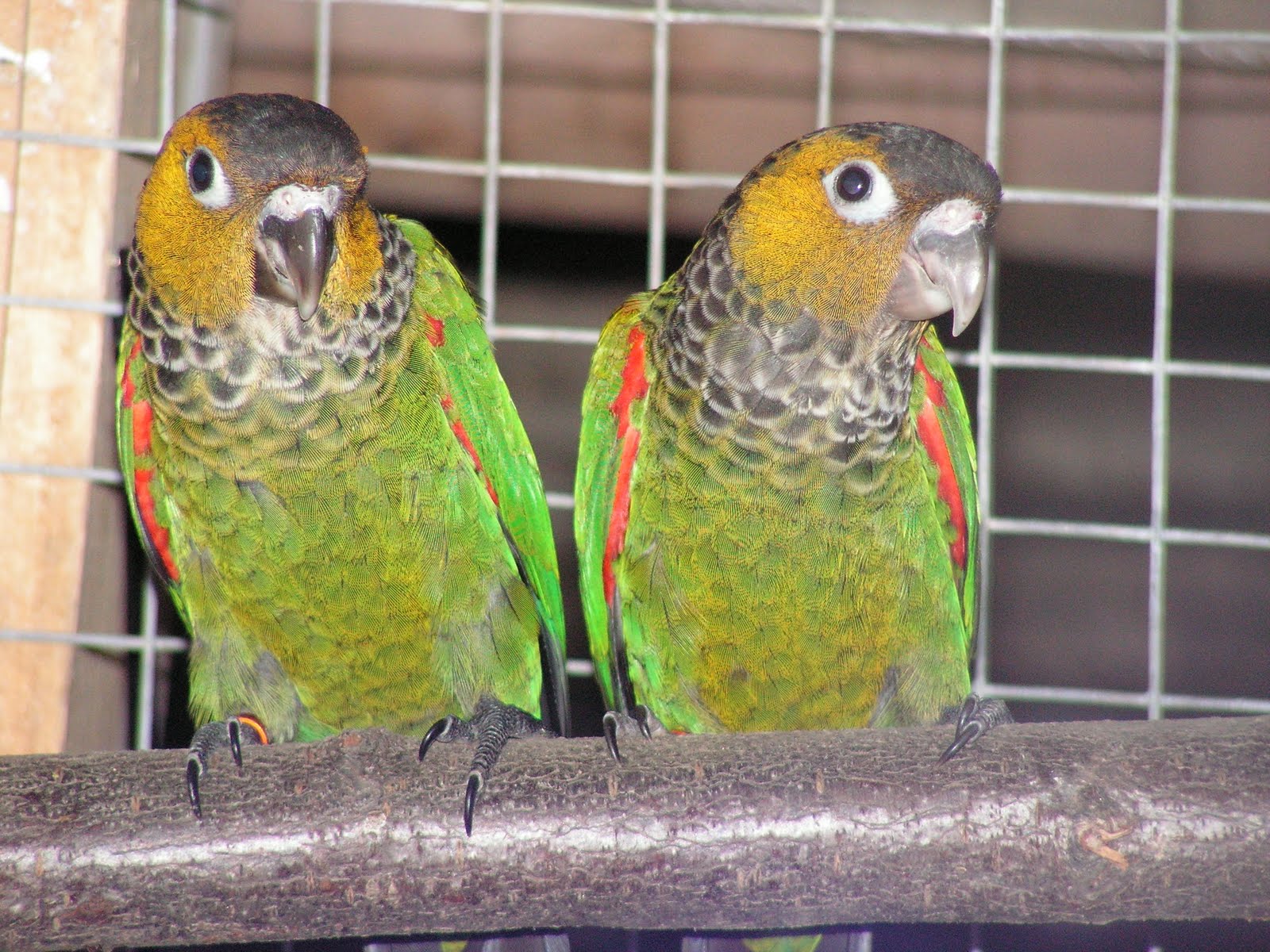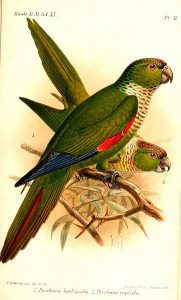Should be noted that until the year 1981, The Blackcap Parakeet was considered a rarity in poultry farming.. From that date began to be imported in quantity although at a very high price.

Content |
|---|
Description:
25 cm. length and 70 g. weight.
The Black-capped Parakeet (Pyrrhura rupicola) has the lores, the forecrown and the Crown, blackish brown; cheeks, ear-coverts and supercilii area, of color olive beige; back of the neck brown with narrow pale edges.
Upperparts green. External primary coverts, alula and leading edge of the wings bright red; other coverts mainly green. The flight feather, mainly bluish green, by top with narrow black tips; grey dark below.
Underwing-coverts green. The throat feathers, sides neck and top of the chest, Black base with wide white margins, becoming yellowish-white at the bottom of the chest and almost no formation of continuous pale band; belly and undertail-coverts green with brown stain in the center of the belly. Upper, the tail mainly green.
The bill slaty-grey; Cere pale grey; bare periophthalmic off-white; irises brown; legs blackish.
Both sexes similar.
The immature has primary coverts almost completely green, as well as the leading edge of the wings.
- Sound of the Black-capped Parakeet.
Subspecies description:
-
Pyrrhura rupicola rupicola
(Tschudi, 1844) – The nominal
-
Pyrrhura rupicola sandiae
(Bond & Meyer de Schauensee, 1944) – It differs from the species nominal much closer to the Gray margins to the feathers of the throat and the front of the neck. These pale fringes measure only 2-2,5 mm. wide (specimens with new plumage) in comparison with the 4-5 mm of the nominal species. Like this, the dark basal portion of these pens is more prominent. It also, the whitish edges to the feathers of the back of the neck they are practically obsolete and the sides of the neck much smaller.
Habitat:
Video – "Black-capped Parakeet" (Pyrrhura rupicola) |
|---|
It lives in the Amazon rainforest., including formations of várzea and the Mainland, below 300 m. Visits have been recorded in the East of the Andes. Fly in flocks of 30 individuals, or small groups in reproductive age.
Reproduction:
It is believed that it can nest in the months of February-March, although the copulation of observed during the month of September. Sunset until the seven eggs in captivity than hatch during 23 to 24 days.
Food:
Usually feed in the canopy but no specific information on diet or breeding.
Distribution:
Can be seen in the Western basin of the amazon. There has been in the East of Peru from the South of Loreto until Mother of God and Puno, and in the North of Bolivia in Pando.
Also distributed in Peace and the Yungas and in the lowlands of the North of Beni, from the East to the border with Rondà´nia in Brazil, with a record until the date in the extreme west of Brazil (Rio Branco, Acre).
In general common (Perhaps more scarce on the edges of the range), but it can be locally decreasing due to the alteration of its habitat.
Subspecies distribution:
-
Pyrrhura rupicola rupicola
(Tschudi, 1844) – The nominal
-
Pyrrhura rupicola sandiae
(Bond & Meyer de Schauensee, 1944) – Southeast of Peru, West end of Brazil and North of Bolivia.
Conservation:
State of conservation ⓘ |
||
|---|---|---|
 Near Threatened ⓘ (UICN)ⓘ
Near Threatened ⓘ (UICN)ⓘ
| ||
• Red List category of the UICN current: Near-threatened
• Population trend: Decreasing
The Parrot Capirotada world population size has not been quantified, but this species is described as “quite common” (Stotz et to the. (1996).
This species is suspected that may be losing from the 13,7 to the 15,5% of their habitat within its distribution over three generations (18 years) based on a model of deforestation of the Amazon (Soares-Filho et to the., 2006, Bird et to the. 2011). Given the susceptibility of this species to be hunted or trapped, leads to the suspicion of a probable decline in population close to the 30% in three generations.
"Black-capped Parakeet" in captivity:
Should be noted that until the year 1981, the Black-capped Parakeet It was considered a rarity in aviculture. From that date began to be imported in quantity although at a very high price.
Their behavior Active, his sympathetic character, their robustness and ease of reproduction attached to the made of own a voice very little annoying, they make an excellent animal for those poultry producers who are initiated into this wonderful hobby. These qualities allow us to intuit that if raised by hand they could be lovely pets.. It is sad to observe that, too often, the main maxim that justifies poultry farming "play to preserve" becomes "play to sell”.
Alternative names:
– Black-capped Parakeet, Black capped Parakeet, Black-capped Conure, Rock Conure, Rock Parakeet (English).
– Conure à cape noire, Perriche à cape noire, Perruche à cape noire (French).
– Schwarzkappensittich, Schwarzkappen-Sittich (German).
– tiriba-rupestre (Portuguese).
– Cotorra Capirotada, Perico de Frente Negra (español).
– Wewey, Aboro gushóus (Chimane).
scientific classification:
– Order: Psittaciformes
– Family: Psittacidae
– Genus: Pyrrhura
– Scientific name: Pyrrhura rupicola
– Citation: (Tschudi, 1844)
– Protonimo: Conurus rupicola
Images "Black-capped Parakeet"
Sources:
– Avibase
– Parrots of the World – Forshaw Joseph M
– Parrots A Guide to the Parrots of the World – Tony Juniper & Mike Parr
– Birdlife
– Photos:
(1) – Pyrrhura rupicola sandiae by pedroduarte
(2) – Maroon-tailed Parakeet ssp. (in front); and Pyrrhura rupicola, Black-capped Parakeet (behind) by John Gerrard Keulemans [Public domain], via Wikimedia Commons
– Sounds: (Xeno-canto)


